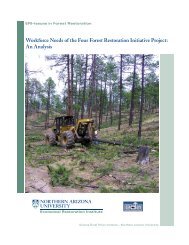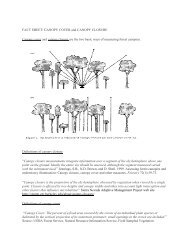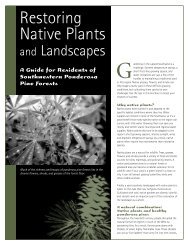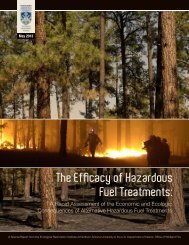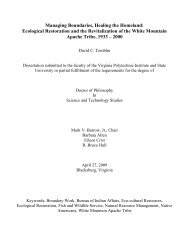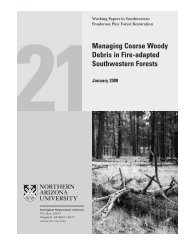Did Tallgrass Prairie Extend into Pennsylvania? - ERI Library ...
Did Tallgrass Prairie Extend into Pennsylvania? - ERI Library ...
Did Tallgrass Prairie Extend into Pennsylvania? - ERI Library ...
Create successful ePaper yourself
Turn your PDF publications into a flip-book with our unique Google optimized e-Paper software.
Laughlin: <strong>Prairie</strong>s in <strong>Pennsylvania</strong> 17small patches of prairie might become invaded completely by drought toleranteastern redcedar (Juniperus virginian a) and other woody species (Laughlin, InPress).The xeric limestone prairies of <strong>Pennsylvania</strong> are very similar to the limestoneprairies in the Ridge and Valley of West Virginia (Bartgis 1993) and these both bearresemblance to the Schizachyrium scoparium-Bouteloua curtipendula prairies insouthern Ohio on the Interior Low Plateau (Fig. 2) (Braun 1928a, I928b, 1951 , 1955).All three of these prairie associations have rather similar species compositions andedaphic conditions and occur on unglaciated soils.Bouteloua curtipendula was the most abundant grass in the limestoneprairies of <strong>Pennsylvania</strong> (Laughlin and Uhl 2003) and West Virginia (Bartgis 1993)within the Ridge and Valley and the second most abundant grass in the limestoneprairies of Ohio (Table I). Schizachyrium scopariu m, the most abundant grass inthe limestone prairies of Ohio, also was found in the limestone prairies of<strong>Pennsylvania</strong>, but to a limited extent.The limestone prairies of the Ridge and Valley and of Ohio were all found onxeric calcareous soils (Braun 1928b, Bartgis 1993, Laughlin and Uhl 2003). TheSchizachyrium scoparium-Bouteloua curtip endula prairie remnants of Ohio occurredon "the uppermost Silurian formations of the Cedarville and Monroedolomites" (Braun 1928b), and flora dominated by Bouteloua curtipendula in<strong>Pennsylvania</strong> occurred on limestone-derived soils. Braun (1928b) described theOhio prairie soils as "very stony ... so much so as to suggest a gravel soil". Soils ofthe limestone prairies in <strong>Pennsylvania</strong> were also extremely rocky, often withexposed limestone bedrock at the surface (Laughlin and Uhl 2003). Rocky soilscontributed solely to limestone prairie maintenance at present (Laughlin, In Press).Braun (1928b) stated that under these dry edaphic conditions "water supply wouldapproach that of a region of lower rainfall [so that] the abundant stored supply ofan evenly distributed annual rainfall so necessary for development of a deciduousforest is not present". In contrast, soils of tallgrass prairie remnants in theMidwest are generally deep, rich loarns (Braun 1928b).Another similarity between Ohio and Ridge and Valley limestone prairies isthat neither lies in the zone of Wisconsin glaciation (Table I). Braun (1928a, 195I)was the first to describe these xeric prairies south of the glacial border and sheattributed their uniqueness to an earlier origin. Some scholars argued they wererelated to the post-Wisconsin Xerothermic extension of prairie <strong>into</strong> Ohio (seeStuckey 198I), but Braun (I 928a, 1951) determined these xeric prairie remnants to bepre-Illinoian in age (greater than 300,000 YBP) because they were not found onglacial till in the Central Lowlands .but were in the distinct, unglaciated region ofthe Interior Low Plateau (Fig. 2). The prairies in the glacial till deposited byWisconsin glaciers were mesic grasslands dominated by Andropogon gerardii,"the typical eastern expression of prairie in the prairie-deciduous forest transitionregion" (Braun 1928a). However, neither the Schizachyrium scoparium-Bouteloua



